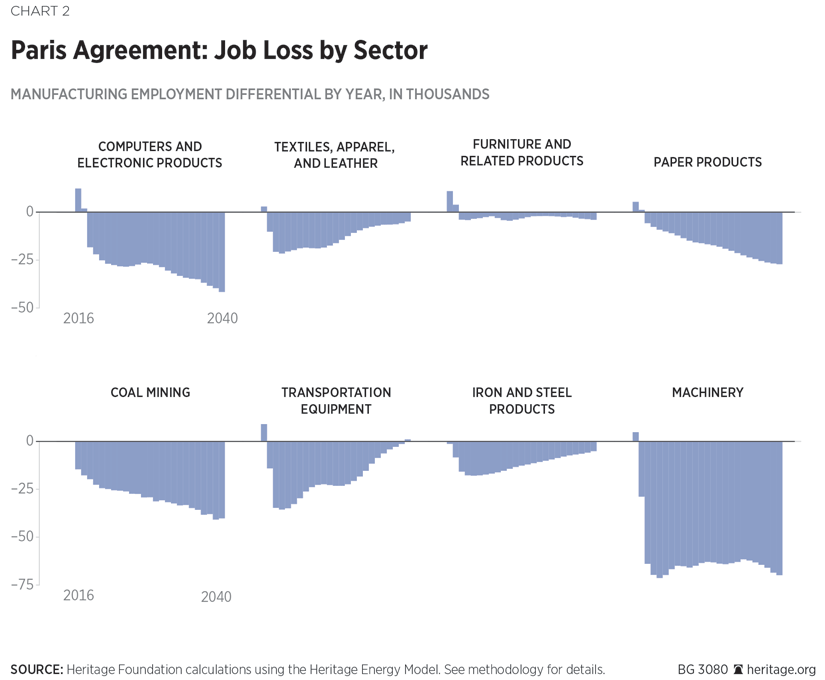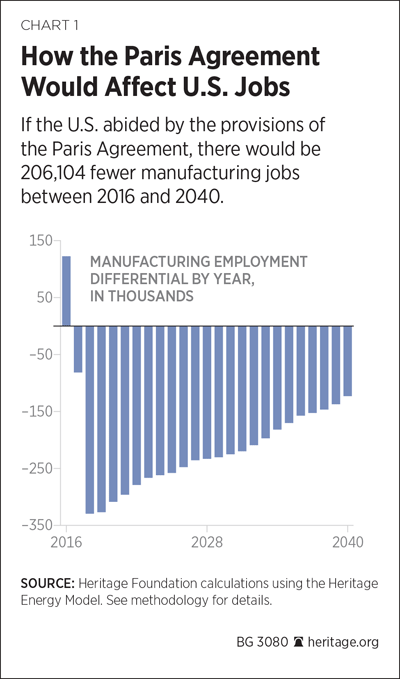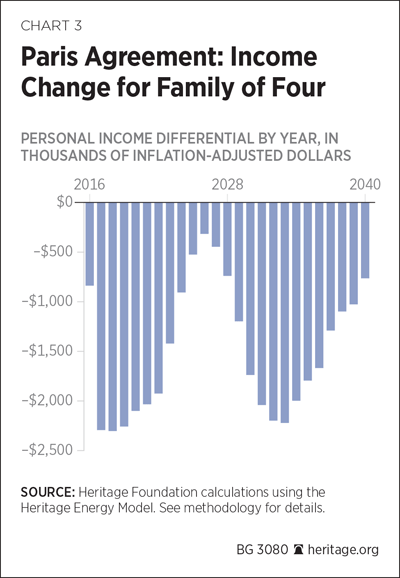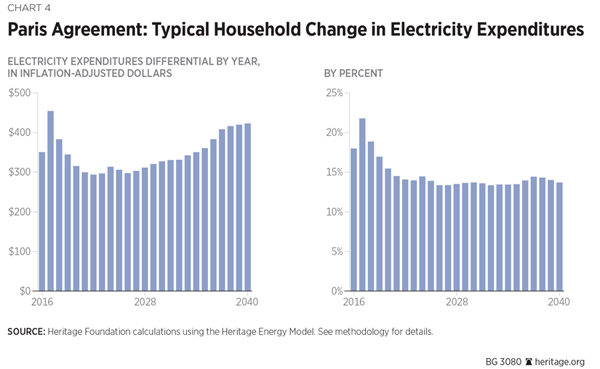During the 2015 United Nations Climate Change Conference in Paris, President Barack Obama met with world leaders from around the globe to discuss plans to combat climate change. The general consensus from the summit was that the use of natural resources, such as coal, oil, and natural gas—which provide 80 percent of the world’s energy needs—should be avoided. Furthermore, industrialized, rich countries should pay for poor countries to build more renewable power and address climate change. In effect, the framework is a push for un-development for the industrialized world and a major obstacle for growth for the developing world. The economic impact of instituting the regulations associated with the Paris agreement will be severe. Policies that restrict the use of carbon-based energy in America will kill jobs and stifle economic growth. Regardless of one’s opinions on the impact of carbon dioxide (CO2) emissions on global temperatures the economic sacrifices will generate a negligible impact on global temperatures.
The Climate Summit in Paris and Domestic Regulations
Leaders from around the world convened at the 2015 U.N. Climate Change Conference in Paris to discuss how to combat climate change. President Obama began the summit by addressing the attendees: “For all the challenges we face, the growing threat of climate change could define the contours of this century more dramatically than any other.”[1] The goal of the conference was for the various countries attending to reach an agreement to limit CO2 emissions in order to reduce global temperatures.
A central element to the U.S. commitment as part of the Paris agreement is the intended nationally determined contribution (INDC) to reduce greenhouse gas emissions. Countries must make specific, measurable commitments to curb carbon dioxide emissions and submit them to the United Nations Framework Convention on Climate Change (UNFCCC) secretariat. The Obama Administration’s INDC aims to reduce U.S. greenhouse gas emissions by 26 percent to 28 percent below 2005 levels by the year 2025.[2] While the INDC is non-binding and the Administration emphasizes that the U.S. “does not intend to utilize international market mechanisms,” the plan outlines the litany of domestic regulations that the Administration proposed and implemented during President Obama’s time in office so far, including:
- Carbon dioxide regulations for new and existing power plants. Combined, these two regulations serve as a major component of the Administration’s global warming agenda.
- Fuel-efficiency and greenhouse gas regulations for light and heavy-duty vehicles.
- Energy-efficiency regulations for commercial and residential buildings as well as appliances.[3]
- Environmental Protection Agency (EPA)-approved alternatives to hydrochlorofluorocarbons.
- Methane regulations for landfills and the oil and gas sector.
- Executive orders to reduce greenhouse gas emissions by the federal government.[4]
The Economic Impact of the Plan
Energy is a key building block for economic opportunity. Carbon-dioxide-emitting fuels, such as coal, oil, and natural gas, provided 87 percent of America’s energy needs in the past decade, and have been the overwhelming supplier for over a century.[5] Restricting the use of conventional energy sources as laid out by the Obama Administration’s INDC will significantly harm the U.S. economy. Americans feel the pain of higher energy prices directly, but also indirectly through almost all of the goods and services they buy, because energy is a necessary component of production and service. Higher energy prices will disproportionately hurt the poorest Americans, who spend the highest percentage of their budget on energy bills.
Companies will pass higher costs on to consumers or absorb the costs, which prevents hiring and new investment. As prices rise, consumers buy less, and companies will drop employees, close entirely, or move to other countries where the cost of doing business is lower. The result is fewer opportunities for American workers, lower incomes, less economic growth, and higher unemployment.
In order to estimate the impact on the economy of the Paris Protocol policies, we estimated the economic impact of a tax equivalent to the EPA’s annual estimates of the social cost of carbon (SCC) in a manner similar to one of our previous studies.[6] Since the crude oil export ban has been lifted, however, we incorporated this change into our simulations of both current policy as well as the Paris agreement. The SCC purports to quantify the economic damages associated with a single metric ton of carbon dioxide emissions over the course of a 300-year time horizon. At their core, these models are fundamentally flawed because their damage functions are arbitrary. Heritage research has also found that these models are extremely sensitive to reasonable changes in assumptions; in fact, under some assumptions one of the models provides a negative SCC, suggesting net economic benefits to carbon dioxide emissions. The Administration insists on using these models anyway.[7]
We used the Heritage Energy Model (HEM),[8] a clone of the National Energy Modeling System 2015 Full Release (NEMS),[9] to quantify the economic impact of instituting the regulations associated with the policies stemming from the Paris agreement. We did so by modeling a $36 carbon tax increasing in conjunction with the EPA’s annual estimates of the SCC. Modeling tax changes as a substitute for quantifying the economic impact of regulatory proposals is a widely accepted practice. To negate the analytical impacts of a tax’s income transfer, 100 percent of carbon-tax revenue is returned to taxpayers.[10]
Policies adapted from domestic regulations emphasized in the Paris agreement will affect a variety of aspects of the American economy. As a result of the plan, one can expect that by 2035, there will be:
- An overall average shortfall of nearly 400,000 jobs;
- An average manufacturing shortfall of over 200,000 jobs;
- A total income loss of more than $20,000 for a family of four;
- An aggregate gross domestic product (GDP) loss of over $2.5 trillion; and
- Increases in household electricity expenditures between 13 percent and 20 percent.
Chart 1 illustrates the impact that American policies adopted from the Paris Protocol will have on employment.
As Chart 1 shows, the impact of the Paris agreement on manufacturing is quite devastating. In terms of overall employment, the agreement ends up killing more than 300,000 jobs by 2035. Chart 2 provides sector-by-sector analysis of this impact.

The impact on personal income that an average family of four would incur is also quite significant, especially toward the end of the next decade. (See Chart 3.)
As global warming regulations stifle the use of the most efficient and inexpensive forms of electricity, businesses as well as households will incur higher electricity costs. Chart 4 shows the average change in annual electricity prices that a typical household will incur.
More results regarding the economic impact are contained in the Appendix.
Negligible Benefits
In his 2015 State of the Union Address, President Obama claimed that “no challenge—no challenge—poses a greater threat to future generations than climate change.”[11] In that case, the President’s policies have missed their mark. Regardless of one’s opinions on the degree to which climate change is occurring, there is compelling evidence that policies like those resulting from the Paris agreement will have little impact on global temperatures.[12] In fact, using the Model for the Assessment of Greenhouse Gas Induced Climate Change developed by researchers at the National Center for Atmospheric Research, even if all carbon dioxide emissions in the United States were effectively eliminated, there would be less than two-tenths of a degree Celsius reduction in global temperatures.[13] In fact, the entire industrialized world could cut carbon emissions down to zero, and the climate impact would still be less than four-tenths of a degree Celsius in terms of averted warming by the year 2100.
In addition, the various country-specific emissions targets for all the countries in the Paris agreement do not offer much hope for climate impact even if all the countries comply perfectly with their promised cuts.[14] History, however, gives little confidence that such compliance will even occur. For instance, China is building 350 coal-fired power plants, and has plans for another 800.[15] Further, if China is not addressing its harmful smog and poor water quality, there is justification for doubting its commitment to addressing global warming. Many developing countries have shown an unwillingness to curb economic growth to reduce greenhouse gas emissions.
Conclusion
Heritage’s clone of the Energy Information Administration’s energy model shows that restricting energy production to meet targets like those of the Paris agreement will significantly harm the U.S. economy. Bureaucratically administered mandates, taxes, and special interest subsidies will drive family incomes down by thousands of dollars per year, drive up energy costs, and eliminate hundreds of thousands of jobs. All of these costs would be incurred to achieve only trivial and theoretical impacts on global warming. Policymakers should therefore make every effort possible to prevent implementation of these harmful environmental regulations.
—Kevin D. Dayaratna, PhD, is Senior Statistician and Research Programmer in the Center for Data Analysis, of the Institute for Economic Freedom and Opportunity, at The Heritage Foundation. Nicolas D. Loris is Herbert and Joyce Morgan Fellow in Energy and Environmental Policy in the Thomas A. Roe Institute for Economic Policy Studies, of the Institute for Economic Freedom and Opportunity. David W. Kreutzer, PhD, is Senior Research Fellow for Energy Economics and Climate Change in the Center for Data Analysis.
Appendix: Methodology
The Heritage Energy Model
The analysis in this Backgrounder uses the Heritage Energy Model (HEM), a derivative of the National Energy Model System 2015 Full Release (NEMS).[16] NEMS is used by the Energy Information Administration (EIA) in the Department of Energy as well as various nongovernmental organizations for a variety of purposes, including forecasting the effects of energy policy changes on a plethora of leading economic indicators. The methodologies, assumptions, conclusions, and opinions in this Backgrounder are entirely the work of statisticians and economists in the Center for Data Analysis (CDA) at The Heritage Foundation, and have not been endorsed by, and do not necessarily reflect the views of, the developers of NEMS.
HEM is based on well-established economic theory as well as historical data, and contains a variety of modules that interact with each other for long-term forecasting. In particular, HEM focuses on the interactions among (1) the supply, conversion, and demand of energy in its various forms; (2) American energy and the overall American economy; (3) the American energy market and the world petroleum market; and (4) current production and consumption decisions as well as expectations about the future.[17] These modules are:
- Macroeconomic Activity Module,[18]
- Transportation Demand Module,
- Residential Demand Module,
- Industrial Demand Module,
- Commercial Demand Module,
- Coal Market Module,
- Electricity Market Module,
- Liquid Fuels Market Module
- Oil and Gas Supply Module,
- Renewable Fuels Module,
- International Energy Activity Module, and
- Natural Gas Transmission and Distribution Module.
With the exception of the Commercial Demand Module, HEM is identical to the EIA’s NEMS. The Commercial Demand Module makes projections regarding commercial floor-space data of pertinent commercial buildings.
Overarching the 12 modules is the Integrating Module, which consistently cycles, iteratively executing and allowing these various modules to interact with each other. Unknown variables that are related, such as a component of a particular module, are grouped together, and a pertinent subsystem of equations and inequalities corresponding to each group is solved via a variety of commonly used numerical analytic techniques, using approximate values for the other unknowns. Once a group’s values are computed, the next group is solved similarly, and the process iterates. Convergence checks are performed for each price and quantity statistic to determine whether subsequent changes in that particular statistic fall within a given tolerance. After all, when group values for the current cycle are determined, the next cycle begins. For example, at cycle j, a variety of n pertinent statistics represented by the vector is obtained.[19] HEM provides a number of diagnostic measures, based on differences between cycles, to indicate whether a stable solution has been achieved.
EIA Simulations and Diagnostics
We used the HEM to analyze the economic effects of the Clean Power Plan. Codes were provided to us by the EIA, which recently performed a similar analysis itself.[20]







